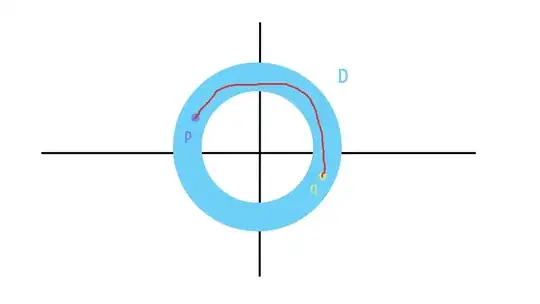Initutively it's super obvious that it's connected. My formal proof goes this way: $x^2 + y^2 = 1$, $ y = mx$ and $x^2 + y^2 = 2$ are connected. Since any point in the region lies in $y = mx$, and $y = mx$ intersects both $x^2 + y^2 = 1$, $ y = mx$ and $x^2 + y^2 = 2$, we use the theorem that "if conneted subpaces has a common point, then their union is connected" to conclude that the whole region is connected. But I think my proof is not elegant and I suspect their exist a simplier reasoning than I used, so I would like to know if that is really the case.
-
Your idea of proof is not correct, because $1 \leq x^2+y^2 \leq 2$ is not the union of the circle with any line. The theorem you quoted does not apply. – Ivo Terek Jan 17 '18 at 20:26
-
I let $m$ vary to include every line from origin – ManishKumar Singh Jan 17 '18 at 20:55
4 Answers
Consider the square $[1,2]\times [0,2\pi]$. This is connected because real intervals are connected (proof) and cartesian product of connected spaces is connected (proof). Since your space is the image of the continuous function $$(r,\theta)\in[1,2]\times [0,2\pi]\mapsto (r\cos(\theta),r\sin(\theta))$$ it's connected because the image of a connected space through a continuous function is connected (proof).
- 16,054
Let $D = \{ (x, y) \ | \ 1 \leq x^2 + y^2 \leq 2\}$ denote the disk.
Observe that for any two points $p, q$ in $D$ there exists a path (a continuous function) $\gamma : [0, 1] \to D$ such that $\gamma(0) = p$ and $\gamma(1) = q$. You only need to draw a picture like the one below to convince yourself of this fact. Note that the red line is the graph of the path $\gamma$.
Hence $D$ is path connected, and thus connected.
In general it is much easier to verify path-connectedness and then use that to prove connectedness, so where you can try and follow this approach.
- 12,972
Show that it is path connected.
Pick two points $A$ and $B$ in your set.
As you mentioned in your proof, you can go from A to the inner boundary via a segment of $ y=m_1 x$ and trace the circle to get to $ y=m_2 x$ which contains $B$
I am sure that you can fill in the details.
- 68,728
The other answers have given you ideas of how to write a correct proof, but no one has yet addressed the correctness of your proof!
Unfortunately your proof is incorrect for a number of reasons, although there are some correct aspects to your reasoning. You talk about points lying in $y = mx$, which is not a correct way of stating the idea that your points lie in a line. Note that $y = mx$ is an equation, not a set; I think you mean $\{(x, y) : y = mx\}$. Of course, you need to preceed this by saying what $m$ is! You've never defined it, and you really should.
The next issue is that lying in a line is not enough to guarantee connectedness; take $[0, 1] \cup [2, 3]$ for example. And the intersection of a line $y = mx$ with your region is not connected - it's a union of two line segments.
The final issue that I'll point out is that even if you take the union of your lines over $m \in \mathbb{R}$, you're missing (almost) all the points on the $y$-axis.
-
By $y=mx$ I mean every line from the origin (so it includes y axis). In my example, I have already established that $x^2 + y^2 =i, i =1,2$ is connected hence union with a connected line is also connected. I hope by this clarification, my proof is fixed. – ManishKumar Singh Jan 17 '18 at 21:01
-
In your example, $[0,1] \cup [2,3] \cup \mathcal{L}$ is connected where $\mathcal{L} $ is a line (I don't know why are you taking intersection). – ManishKumar Singh Jan 17 '18 at 21:02
-
@ManishKumarSingh My point is that if you take a line through the origin and consider its intersection with your annular region, it is not connected. It consists of two components. So your invocation of the theorem that the union of two connected sets is connected has some holes in it. – Jan 18 '18 at 20:30
